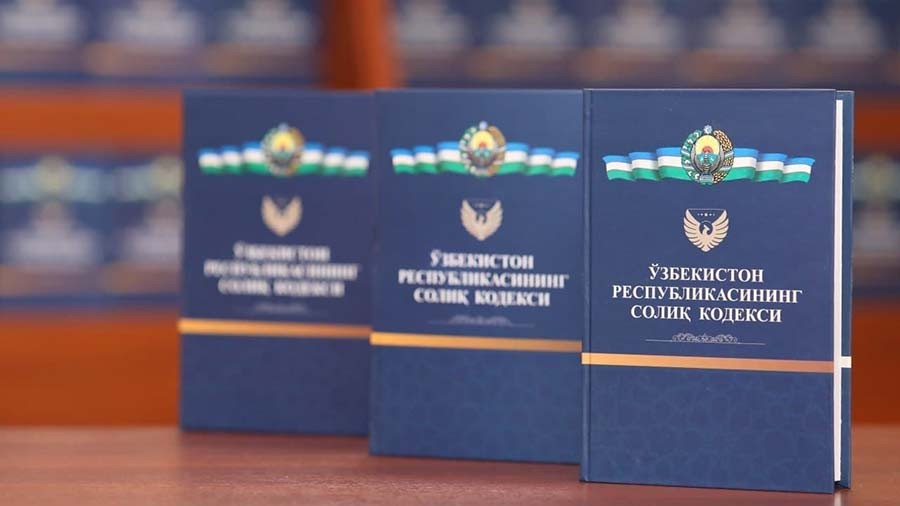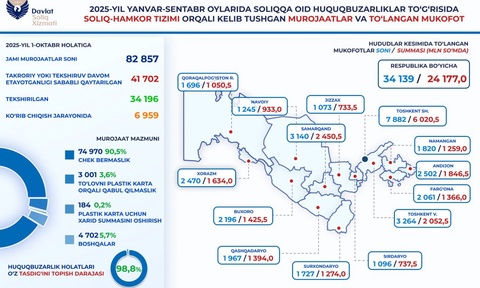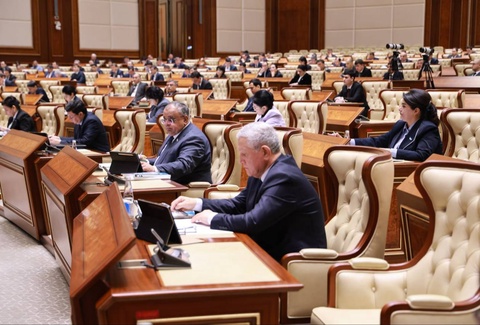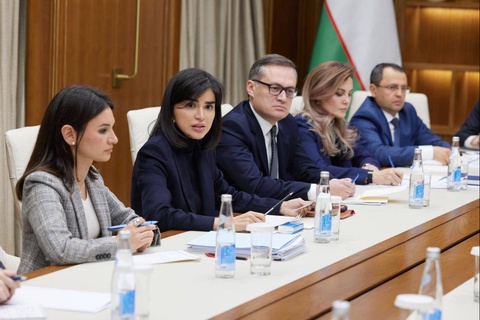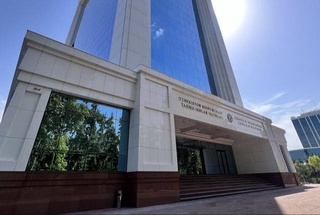VAT
The procedure for calculating and paying tax is preserved, as well as a tax rate of 15%.
1.2. The range of enterprises paying VAT regardless of the volume of proceeds is expanding at the expense of stationary outlets for the retail sale of alcoholic beverages, including beer, markets and shopping centers.
1.3. For taxpayers whose sales turnover of goods (services) does not exceed one billion soums per month, the tax period is set as a quarter.The procedure for applying benefits at the expense of funds from international financial institutions and foreign government financial organizations has been clarified.
Now, the turnover for the sale and import of goods (services) acquired through loans from international financial institutions and international loans from government organizations will be exempted, if their release is provided for by law.
Based on this, amendments have been made to Articles 243 and 246 of the Tax Code.
Excise tax
2.1. The procedure for calculating and paying excise tax is preserved.
2.2. Excise tax rates are established by the Tax Code (Articles 2891-2893). At the same time, when calculating the excise tax upon import, before the approval of the relevant decision of the Cabinet of Ministers, the TN VED codes are applied, operating in accordance with the presidential decree No. PP-3818.
In the absence of a commodity item in Articles 2891-2893, respectively, the excise tax on the missing commodity items is not charged.
The excise tax was abolished on 73 items, including on electrical products (refrigerators, air conditioners, washing machines), tractors and semi-trailers, food products (margarine, confectionery and other products), etc.
2.3. When using imported (imported) excisable goods sold to the end consumer (gasoline, diesel fuel, liquefied and compressed gas) for their own needs, taxpayers are the persons who import these goods for their own needs.
2.4. Natural wines (with the exception of bottled) sold by producers in tasting zones (places) organized along tourist routes are not subject to taxation.
Income tax
3.1. The procedure for calculating and paying income tax, as well as tax rates in effect in 2020, is preserved.
3.2. Starting from January 1, 2021, property received or acquired (created) at the expense of funds received in accordance with paragraphs 8, 9, 14, 15 and 17 of Article 304 of the Tax Code, as well as received or acquired (created) at the expense of funds released as a result of tax and customs benefits granted, are not recognized as depreciable assets and are not subject to depreciation.
The cost of the depreciable asset is expensed through depreciation charges
calculated from the original cost without taking into account their revaluation.
The cost of depreciable assets, taking into account the previously carried out revaluation, held by the taxpayer according to accounting data as of January 1, 2021, is the historical cost for tax purposes.
Starting from January 1, 2021, when a taxpayer performs a revaluation of depreciable assets in subsequent reporting (tax) periods, the result of such revaluation for tax purposes is not taken into account when calculating depreciation charges.
3.3. The calculation of advance payments by tax authorities on the basis of the previous reporting period is retained.
At the same time, the taxpayer has the right to submit to the tax authorities a certificate of the amount of advance payments by the 10th day of the first month of the next quarter, based on the expected amount of profit in the current quarter. Previously, this norm was provided for in the presidential decree No. UP-5978.
Sales tax
6.1. The procedure for calculating and paying value added tax is preserved.
6.3. The tax rate for persons engaged in real estate activities is reduced from 25 to 13%.
For the rest of the category of taxpayers, the tax rates in effect in 2020 remain the same.
Property tax
7.1. The procedure for calculating and paying property tax for legal entities and individuals is preserved, as well as the base tax rate for legal entities at the rate of 2%.
The gradual increase of the reduced tax rate for legal entities to the base one continues by increasing the reduced tax rate established for the objects provided for in part four of Article 415 of the Tax Code from 0.2 to 0.4%.
A reduced tax rate for legal entities was introduced from January 1, 2020 in respect of objects for which tax incentives were previously granted.
At the same time, in 2021 for individuals, the amount of tax calculated on the basis of the cadastral value determined in 2018 cannot exceed the amount of tax accrued for 2020 by more than 30%.
7.2. The tax exemption is canceled in the part of sanatorium-resort facilities located in tourist areas.
At the same time, the Zhokargy Kenes of the Republic of Karakalpakstan and the Kengashes of people’s deputies of the regions were given the right to establish a reduced tax rate or exemption from property tax in respect of land plots occupied by individual sanatorium facilities located in tourist zones.
Land tax
8.2. The Tax Code establishes basic tax rates for non-agricultural land (in absolute terms) for legal entities and individuals, in the context of the regions of the republic.
The specific amount of tax rates for non-agricultural land is determined in the following order:
The Jokargy Kenes of the Republic of Karakalpakstan and the Kengashi of people’s deputies of the regions set tax rates for non-agricultural land in the context of districts and cities, depending on their economic development, based on the basic tax rates established in the Tax Code, using decreasing and increasing coefficients from 0.5 to 2 , 0;Kengashes of people’s deputies of districts and cities introduce decreasing and increasing coefficients from 0.7 to 3.0 to the tax rates established by the Jokargy Kenes of the Republic of Karakalpakstan and Kengashes of people’s deputies of regions, and for the city of Tashkent – to the basic tax rates established in the Tax Code, in a section of a quarter, massif, makhalla, streets located on their territory. At the same time, Kengashes of people’s deputies of districts and cities have the right to establish land tax rates increased up to 3 times in relation to individual land plots, as well as land plots in the use of individuals with an area of more than 1 hectare located in the tourist zones of the republic.
Tax rates for 2021 are submitted by Kengashes of people’s deputies of districts and cities to the tax authorities at the location of the non-agricultural land plot until December 31, 2020.
The tax authorities at the location of the land plot are obliged to inform taxpayers within five days of these tax rates in order to calculate the land tax from legal entities for non-agricultural land.
8.5. The gradual increase of the reduced tax rate to the base rate continues by increasing the reduction coefficient applied to the tax rates for legal entities with respect to land plots occupied by individual objects provided for in article 429 of the Tax Code from 0.1 to 0.25.
The reducing coefficient to the land tax rates was introduced from January 1, 2020, in relation to objects for which tax incentives were previously granted. 8.6. Land plots allocated for storage of all types of waste and their disposal are excluded from the object of taxation by land tax from legal entities.
8.7. The tax exemption for legal entities is canceled in terms of land occupied by:
- sanatorium and resort facilities located in tourist areas;
- places of rest and health improvement of mothers, rest homes. At the same time, the Zhokargy Kenes of the Republic of Karakalpakstan and the Kengashes of people’s deputies of the regions were given the right to establish a reduced tax rate or exemption from land tax in respect of land plots occupied by individual sanatorium facilities located in tourist zones.8.8. The tax incentive for the introduction of water-saving technologies is being expanded by including other types of water-saving technologies. Until January 1, 2021, only those taxpayers who used the drip irrigation system could benefit from the tax benefit.
Since January 1, 2021, land is also exempted from tax on which other types of water-saving irrigation technologies (sprinkler, discrete and other (including drip) have been introduced) – for a period of five years from the beginning of the month in which water-saving irrigation technology has been introduced. provided on the basis of the conclusion of the authorized body in the field of water use and water consumption. In the event that the system of water-saving irrigation technologies is not usable or dismantled within five years from the beginning of the month in which it was introduced, the tax benefit is canceled with the restoration of the obligation to pay tax for the entire period of application of the tax benefit.
Water use tax
9.6. A procedure has been introduced according to which taxpayers engaged in several types of activities for which various objects of taxation and (or) tax rates have been established are required to keep separate records for such types of activities and pay tax at the appropriate tax rates.
For example: the main activity of the taxpayer is trade, but at the same time he also has a car wash. In this case, the taxpayer keeps separate accounting records for these types of activities and calculates the tax:
- by the volume of water used for trading activities at a tax rate of 182 soums per 1 cubic meter. (surface sources of water resources) and 221 soums per 1 cubic meter (underground sources of water resources);
- by the volume of water used for washing vehicles at a tax rate of 1,990 soums per 1 cubic meter.
Subsoil use tax
10.1. The procedure for calculating and paying tax for the use of subsoil is preserved.
10.2. A unified tax rate is established in the amount of 5%, but not less than 7,500 sum cubic meter, for the following types of minerals:
- construction sand,
- sand and gravel,
- sandstones,
- crushed stone (carbonate rocks),
- construction crushed stone (granites, porphyrites and shale rocks).
Tax rates for SE “Navoi Mining and Metallurgical Plant” and JSC “Almalyk Mining and Metallurgical Plant”
for gold, silver, palladium and copper are set at 15%.
For other types of minerals, the tax rates in effect in 2020 remain the same.
Other taxes
11.2. Canceled from January 1, 2021 for all economic entities, regardless of ownership, an annual mandatory revaluation of fixed assets.
11.3. The period for applying a zero rate of customs duty has been extended when importing 20 types of goods into the country (excluding white and other sugar).


